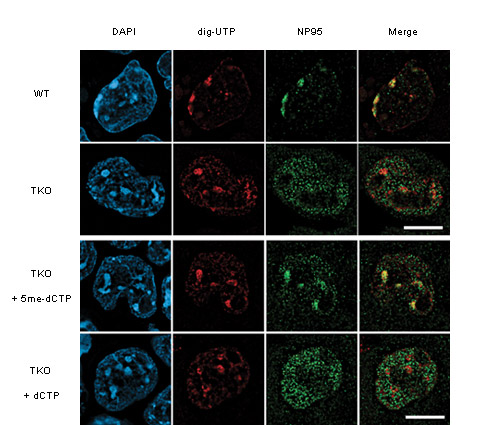| RIKEN Center for Developmental Biology (CDB) 2-2-3 Minatojima minamimachi, Chuo-ku, Kobe 650-0047, Japan |
Now, a joint study conducted by researchers at RIKEN RCAI, Tohoku University, and the CDB Laboratory for Mammalian Epigenetic Studies, has revealed a molecular mechanism by which DNMT1, an enzyme that helps to maintain the heritability of DNA methylation, is recruited to appropriate sites in the genome during replication. Shin-Ichiro Takebayashi, a research scientist in the Okano lab, performed cytological analyses that enabled the collaboration to show the involvement of the protein Np95 in Dnmt1 recruitment. The team’s work has been published in the journal Nature.
DNA methylation takes the form of de novo establishment and subsequent inheritance, processes that are dependent on different members of the DNA methyltransferase (Dnmt) family of enzymes: Dnmt3a and -3b work in de novo methylation, while Dnmt1 functions in inheritance. Such occurs in stretches of DNA known as CpG islands, which are abundant in otherwise relatively uncommon cytosine-guanine di-nucleotide pairings. Methyl groups selectively bind to cytosine in these two-base sequences. Takebayashi and colleagues were interested specifically in the potential role of Np95, a mouse protein that functions in cell cycle progression, DNA repair and chromatin replication, and which is closely related to a factor known to be involved in the recognition of methylated CpG islands and DNA methylation in plants. When they looked at wildtype embryonic stem cells, they found that Np95 co-localized with Dnmt1 in replicating nuclei. In cells engineered to lack all three known DNA methyltransferases, Dnmt1, Dnmt3a and Dnmt3b, however, not only was DNA methylation activity lost, but Np95 failed to localize and remained diffusely expressed throughout the triple knockout ES cells as well. Intriguingly, when they induced the methylation of only a single strand of the replicating DNA in these mutant cells, the Np95 localization resumed, suggesting that Np95 must be capable of recognizing and binding to “hemi-methylated” sites in which only one of the two strands of replicating DNA is modified by a methyl group. Mice carrying mutations in the Np95 gene showed a failure of DNA methylation and embryonic lethality, pointing to a critical role for this protein, while in Np95- cells, Dnmt1 failed to accumulate at heterochromatic domains. This set of findings suggests that Np95 is somehow capable of recognizing hemi-methylated DNA during replication, and recruiting Dnmt1, thereby ensuring that both sets of DNA will bear the same methyl modifications. While the mechanistic details behind this activity are still unknown, the model that emerges from this study goes a long way toward explaining one of the great mysteries of epigenetic inheritance. “These results extended our understanding of epigenetic inheritance by DNA methylation,” says Okano. “Further mechanistic analyses may provide clues for a better understanding of DNA methylation-reducing process during epigenetic reprogramming or aberrant DNA methylation in cancer.”
|
|||||
|
|||||
 |
| Copyright (C) CENTER FOR DEVELOPMENTAL BIOLOGY All rights reserved. |
